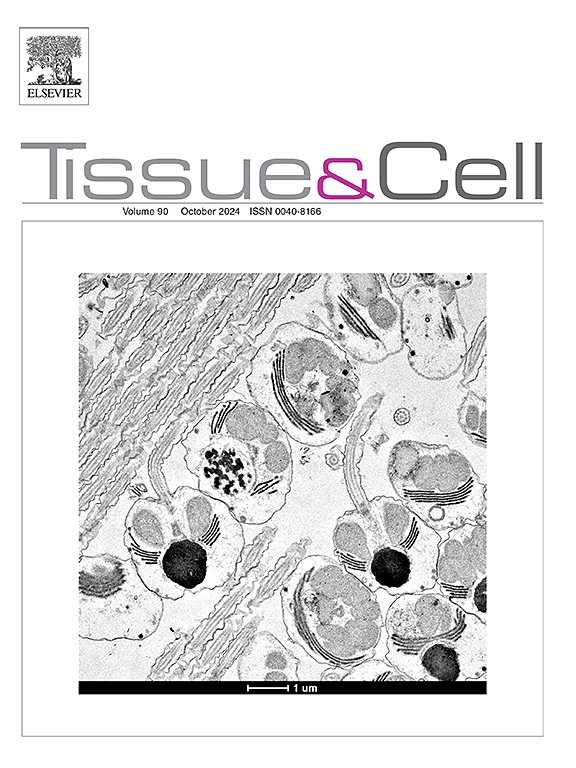Enhanced hepatoprotective efficacy of quercetin nanoparticles versus free quercetin against acrylamide-induced hepatotoxicity through modulation of MAPK/NF-κB/NLRP3 signaling pathways and molecular docking validation
IF 2.7
4区 生物学
Q1 ANATOMY & MORPHOLOGY
引用次数: 0
Abstract
Acrylamide (ACR) is a hazardous contaminant posing significant hepatotoxic risks. This study investigates the hepatoprotective efficacy of quercetin-loaded nanoparticles compared to free quercetin in mitigating ACR-induced hepatotoxicity. Nanoparticles were formulated using nanoprecipitation with galactose-functionalized surfaces to enhance liver targeting. Rats were allocated into five groups: control, ACR-induced hepatotoxicity, blank nanoparticles, free quercetin, and quercetin nanoparticles. Hepatotoxicity was assessed through biochemical, molecular, histopathological, and immunohistochemical analyses, along with molecular docking studies. Results demonstrated significant elevations in hepatic enzyme levels (ALT, AST), oxidative stress markers (MDA), inflammatory mediators (MAPK, NF-κB1, NLRP3, IL-1β, IL-6), and apoptotic factors (CASP3, BAX, P53), alongside reductions in antioxidant enzymes (GSH, GPx) in the ACR group. Both quercetin treatments effectively reduced these adverse effects, with quercetin nanoparticles exhibiting superior performance, evidenced by a 25 % greater reduction in oxidative markers and a 30 % increase in antioxidant enzyme activity. Molecular docking confirmed strong interactions between quercetin and key inflammatory pathway proteins (MAPK, NF-κB, NLRP3). Enhanced bioavailability and targeted delivery contributed to the nanoparticles' superior efficacy. These findings suggest that quercetin nanoparticles significantly outperform free quercetin in ameliorating ACR-induced hepatotoxicity by attenuating oxidative stress, inflammation, and apoptosis, providing a robust foundation for their future clinical exploration..
通过调节MAPK/NF-κB/NLRP3信号通路和分子对接验证,槲皮素纳米颗粒对丙烯酰胺诱导的肝毒性的保护作用强于游离槲皮素
丙烯酰胺(ACR)是一种具有显著肝毒性风险的有害污染物。本研究比较了负载槲皮素纳米颗粒与游离槲皮素在减轻acr诱导的肝毒性中的保护作用。采用半乳糖功能化表面的纳米沉淀法制备纳米颗粒,以增强肝脏靶向性。将大鼠分为对照组、acr肝毒性组、空白纳米颗粒组、游离槲皮素组和槲皮素纳米颗粒组。肝毒性通过生化、分子、组织病理学和免疫组织化学分析以及分子对接研究进行评估。结果显示,ACR组肝脏酶(ALT、AST)、氧化应激标志物(MDA)、炎症介质(MAPK、NF-κB1、NLRP3、IL-1β、IL-6)和凋亡因子(CASP3、BAX、P53)水平显著升高,抗氧化酶(GSH、GPx)水平降低。两种槲皮素处理都有效地减少了这些不良反应,槲皮素纳米颗粒表现出更好的性能,氧化标记物减少了25% %,抗氧化酶活性增加了30% %。分子对接证实槲皮素与关键炎症通路蛋白(MAPK、NF-κB、NLRP3)之间存在强相互作用。增强的生物利用度和靶向递送有助于纳米颗粒的优越疗效。这些研究结果表明,槲皮素纳米颗粒通过减轻氧化应激、炎症和细胞凋亡,在改善acr诱导的肝毒性方面明显优于游离槲皮素,为其未来的临床探索提供了坚实的基础。
本文章由计算机程序翻译,如有差异,请以英文原文为准。
求助全文
约1分钟内获得全文
求助全文
来源期刊

Tissue & cell
医学-解剖学与形态学
CiteScore
3.90
自引率
0.00%
发文量
234
期刊介绍:
Tissue and Cell is devoted to original research on the organization of cells, subcellular and extracellular components at all levels, including the grouping and interrelations of cells in tissues and organs. The journal encourages submission of ultrastructural studies that provide novel insights into structure, function and physiology of cells and tissues, in health and disease. Bioengineering and stem cells studies focused on the description of morphological and/or histological data are also welcomed.
Studies investigating the effect of compounds and/or substances on structure of cells and tissues are generally outside the scope of this journal. For consideration, studies should contain a clear rationale on the use of (a) given substance(s), have a compelling morphological and structural focus and present novel incremental findings from previous literature.
 求助内容:
求助内容: 应助结果提醒方式:
应助结果提醒方式:


